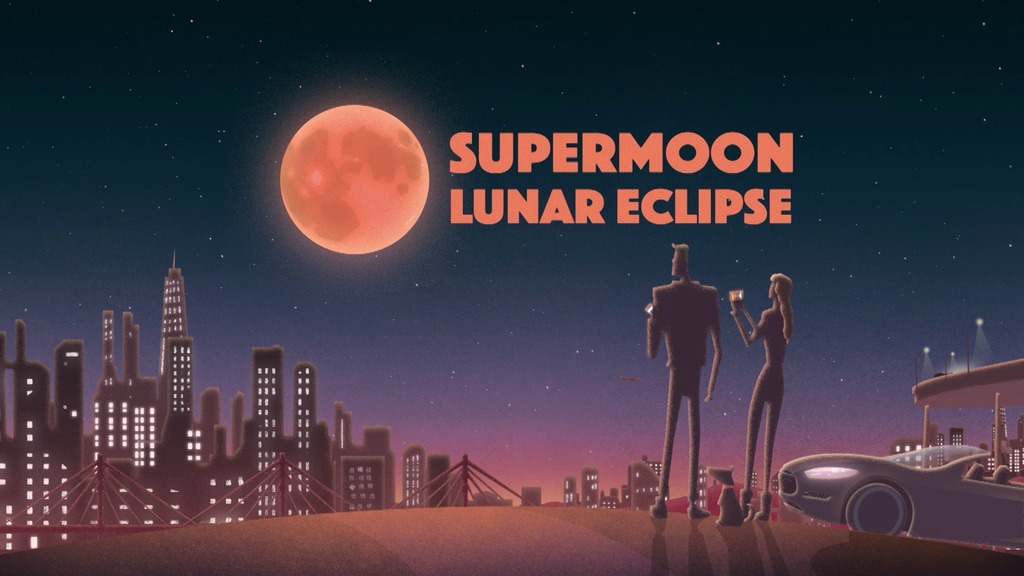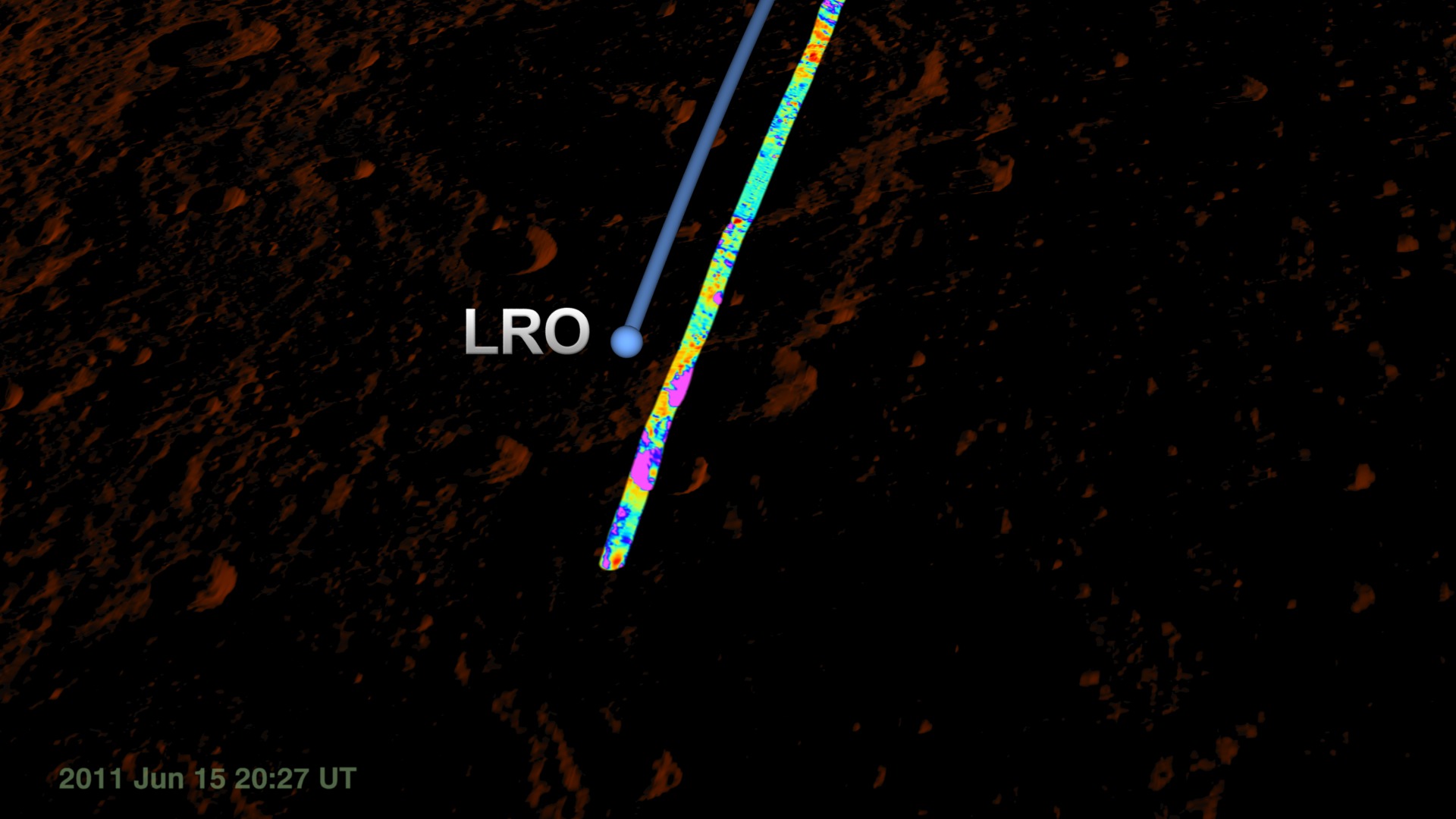Lunar Eclipse
Overview
This gallery contains videos and visualizations related to Lunar Eclipses
2022 Visualizations
November 8, 2022 Total Lunar Eclipse: Shadow View
Go to this pageUniversal Time (UTC). The Moon moves right to left, passing through the penumbra and umbra, leaving in its wake an eclipse diagram with the times at various stages of the eclipse. || shadow_diagram_utc_202211_print.jpg (1024x576) [79.0 KB] || shadow_diagram_utc_202211_searchweb.png (320x180) [44.6 KB] || shadow_diagram_utc_202211_thm.png (80x40) [4.8 KB] || umbracam_utc_202211_1080p30.mp4 (1920x1080) [13.1 MB] || umbracam_utc_202211_720p30.mp4 (1280x720) [7.2 MB] || umbracam_utc_202211_720p30.webm (1280x720) [11.0 MB] || umbracam_utc_202211_2160p30.mp4 (3840x2160) [37.3 MB] || umbracam_utc_202211_360p30.mp4 (640x360) [2.6 MB] || utc (3840x2160) [128.0 KB] || shadow_diagram_utc_202211.tif (3840x2160) [5.8 MB] ||
November 8, 2022 Total Lunar Eclipse: Visibility Map
Go to this pageAn animated map showing where the November 8, 2022 lunar eclipse is visible. Contours mark the edge of the visibility region at eclipse contact times. The map is centered on 168°57'W, the sublunar longitude at mid-eclipse. || map.0865_print.jpg (1024x576) [102.6 KB] || map.0865_searchweb.png (320x180) [41.6 KB] || map.0865_thm.png (80x40) [4.5 KB] || vismap_202211_1080p30.mp4 (1920x1080) [23.3 MB] || vismap_202211_720p30.mp4 (1280x720) [12.1 MB] || vismap_202211_720p30.webm (1280x720) [11.0 MB] || vismap_202211_2160p30.mp4 (3840x2160) [76.2 MB] || vismap_202211_360p30.mp4 (640x360) [4.0 MB] || map (3840x2160) [128.0 KB] ||
May 15-16, 2022 Total Lunar Eclipse: Shadow View
Go to this pageEastern Daylight Time (EDT). The Moon moves right to left, passing through the penumbra and umbra, leaving in its wake an eclipse diagram with the times at various stages of the eclipse. || shadow_diagram_edt_202205_print.jpg (1024x576) [85.9 KB] || moon.2355_searchweb.png (320x180) [48.4 KB] || moon.2355_thm.png (80x40) [5.0 KB] || umbracam_edt_202205_1080p30.mp4 (1920x1080) [12.2 MB] || umbracam_edt_202205_720p30.mp4 (1280x720) [6.7 MB] || umbracam_edt_202205_720p30.webm (1280x720) [9.4 MB] || umbracam_edt_202205_2160p30.mp4 (3840x2160) [35.5 MB] || umbracam_edt_202205_360p30.mp4 (640x360) [2.4 MB] || shadow_diagram_edt_202205.tif (3840x2160) [6.7 MB] || edt (3840x2160) [128.0 KB] ||
May 15-16, 2022 Total Lunar Eclipse: Visibility Map
Go to this pageAn animated map showing where the May 15-16, 2022 lunar eclipse is visible. Contours mark the edge of the visibility region at eclipse contact times. The map is centered on 63°52'W, the sublunar longitude at mid-eclipse. || map.0718_print.jpg (1024x576) [99.7 KB] || map.0718_searchweb.png (320x180) [48.5 KB] || map.0718_thm.png (80x40) [5.3 KB] || vismap_202205_1080p30.mp4 (1920x1080) [18.7 MB] || vismap_202205_720p30.mp4 (1280x720) [9.9 MB] || vismap_202205_720p30.webm (1280x720) [9.2 MB] || vismap_202205_2160p30.mp4 (3840x2160) [60.8 MB] || vismap_202205_360p30.mp4 (640x360) [3.4 MB] || map (3840x2160) [128.0 KB] ||
Videos
Lunar Eclipse Essentials - Updated
Go to this pageLearn more about how a lunar eclipse works by watching this video! || LunarEclipseEssentialThumbnail.jpg (1280x720) [319.2 KB] || LunarEclipseEssentialsThumbnail1.jpg (1280x720) [284.0 KB] || LunarEclipseEssentialThumbnail_print.jpg (1024x576) [267.9 KB] || LunarEclipseEssentialThumbnail_searchweb.png (320x180) [89.3 KB] || LunarEclipseEssentialThumbnail_thm.png (80x40) [5.5 KB] || Lunar_Eclipse_Essentials_UPDATED_YouTube.mp4 (1280x720) [203.5 MB] || Lunar_Eclipse_Essentials_UPDATED.mov (1280x720) [1.6 GB] || Lunar_Eclipse_Essentials_UPDATED_YouTube.webm (1280x720) [13.9 MB] ||
Need To Know: Lunar Eclipse and LRO
Go to this pageOn April 15th, 2014 there will be a total lunar eclipse visible from North America. Noah Petro, LRO Deputy Project Scientist, discusses this unique event and what effect it will have on the Lunar Reconnaissance Orbiter (LRO). ||
Understanding Lunar Eclipses
Go to this pageWhat can cause the full Moon to quickly darken, then glow red? A lunar eclipse: a striking display of orbital mechanics that occurs when the Moon passes through the Earth's shadow. To learn more, watch the video below. ||
Supermoon Lunar Eclipse
Go to this pageThis animated video explains a rare event happening on September 27th, 2015 - a supermoon lunar eclipse. For complete transcript, click here.Watch this video on the NASAexplorer YouTube channel. || Supermoon_Lunar_Eclipse_MASTER_youtube_hq_print.jpg (1024x576) [110.5 KB] || Supermoon_Lunar_Eclipse_MASTER_youtube_hq_searchweb.png (320x180) [76.5 KB] || Supermoon_Lunar_Eclipse_MASTER_youtube_hq_thm.png (80x40) [5.4 KB] || Supermoon_Lunar_Eclipse_MASTER_youtube_hq.mov (1920x1080) [248.6 MB] || PRORES_B-ROLL_Supermoon_Lunar_Eclipse_MASTER_prores.mov (1280x720) [1.3 GB] || NASA_TV_Supermoon_Lunar_Eclipse_MASTER.mpeg (1280x720) [328.8 MB] || APPLE_TV_Supermoon_Lunar_Eclipse_MASTER_appletv.m4v (1280x720) [48.2 MB] || WMV_Supermoon_Lunar_Eclipse_MASTER_HD.wmv (1920x1080) [17.2 MB] || Supermoon_Lunar_Eclipse_MASTER.mov (1920x1080) [2.4 GB] || Supermoon_Lunar_Eclipse_MASTER_youtube_hq.webm (1920x1080) [10.2 MB] || APPLE_TV_Supermoon_Lunar_Eclipse_MASTER_appletv_subtitles.m4v (1280x720) [48.3 MB] || Supermoon_Lunar_Eclipse_MASTER_youtube_hq.en_US.srt [1.6 KB] || Supermoon_Lunar_Eclipse_MASTER_youtube_hq.en_US.vtt [1.6 KB] || NASA_PODCAST_Supermoon_Lunar_Eclipse_MASTER_ipod_sm.mp4 (320x240) [18.3 MB] ||
Hubble Views the Moon to Study Earth
Go to this pageTaking advantage of the total lunar eclipse of January 2019, astronomers, using NASA’s Hubble Space Telescope, have measured the amount of ozone in the Earth’s atmosphere. The method used serves as a proxy for how they will observe earthlike planets around other stars in search for worlds similar to our own.For more information, visit https://nasa.gov/hubble.Visualizations:NASA/GSFC: K. Kim — Moonbounce AnimationESA, NASA and L. Calçada (ESO) — Artist's concept of exoplanet orbiting FomalhautESA, Hubble, M. Kornmesser —Absorption Lines & ExoplanetsNASA/GSFC: Chris Smith — TOI 700 system transit Animation ESA, Hubble, M. Kornmesser & L. L. Christensen — HD 189733b transiting its parent star (artist's impression) ESA, ESO/L. Calçada, M. Kornmesser & L. L. Christensen (ESA/Hubble) — Exoplanet Transit MethodVideos & Images: NASA Goddard Space Flight Center European Space AgencySpace Telescope Science InstituteJanuary 2019 Moon Image taken by Kevin HartnettArtbeats Stock Footage — Footage of leafPond5 Stock Footage — Footage of weeping willowfootagefirm — Footage of sunrise and cloudsMusic Credits:“Life Unplanned” by Paul Saunderson [ PRS ]. Abbey Road Masters [ PRS ], and Universal Production Music ||
More Visualizations
Lunar Eclipses and the Moon's Orbit
Go to this pageThe animations on this page illustrate the Moon’s orbit and its role in lunar and solar eclipses. A solar eclipse happens when the Moon’s shadow falls on the Earth, while a lunar eclipse happens when the Earth’s shadow falls on the Moon.Eclipses can only happen at New and Full Moon, when the Earth, Moon, and Sun are all in a straight line. But they don’t happen every New and Full Moon, because the Moon’s orbit is tilted by about 5 degrees. As the Earth and Moon travel around the Sun, the tilt of the Moon’s orbit changes direction relative to the Sun.This is analogous to the way the tilt of the Earth causes seasons. Just like winter and summer happen every six months, eclipses tend to occur on a roughly six-month cycle.Unlike most eclipse shadow diagrams, the first three animations here don’t greatly exaggerate the scale of the Earth and Moon. They are only 2x their true scale. The view is exactly perpendicular to the Earth-Sun line. The angle of the Moon’s orbital tilt and the “tapering” of the shadows are both accurate. The orbit happens to be calculated for the months preceding the April 15, 2014 total lunar eclipse. ||
LRO's Diviner during the June 15, 2011 Lunar Eclipse
Go to this pageFor Lunar Reconnaissance Orbiter (LRO), the lunar eclipse on June 15, 2011 is likely to be the longest and darkest of its life. This matters because LRO relies on sunlight to power its systems and instruments. Although it spends half of every orbit on the night side of the Moon, each night side pass lasts only an hour. For the June 15 eclipse, LRO will be in the dark for more than twice as long.During a previous total eclipse, LRO hibernated, turning off all of its instruments to conserve its battery power until the Moon emerged from the Earth's shadow. For the June 15 event, LRO will leave on the Diviner Lunar Radiometry Experiment. Diviner will measure the cooling of the Moon's surface during the eclipse. This unique temperature record is expected to reveal information about the roughness and composition of the swath of lunar surface visible to Diviner's sensors during the eclipse.The visualization archived on this page shows LRO flying over the lunar surface during the darkest part of the eclipse, with Diviner measuring temperatures along a swath about 3.5 kilometers wide. LRO will pass this part of the surface again during the eclipse, and it will tilt a bit so that Diviner can point at the same strip of lunar surface. The difference between the two temperature readings gives the rate of cooling at each point along the swath.Other visualizations in this series depict the view of the eclipsefrom the Moon, where the event is a solar eclipsealong the shadow line, with the figures of the umbra, penumbra, and lunar and solar pathsthrough a telescope on EarthA narrated piece that uses these visualizations is in entry #10794. For an explanation of lunar eclipses, visit entry #10787. ||
Lunar Eclipse of April 15, 2014 As Viewed from the Moon
Go to this pageIn the early morning hours of April 15, 2014, the Moon enters the Earth’s shadow, creating a total lunar eclipse. When viewed from the Moon, as in this animation, the Earth hides the Sun. A red ring, the sum of all Earth’s sunrises and sunsets, lines the Earth’s limb and casts a ruddy light on the lunar landscape. With the darkness of the eclipse, the stars come out.The city lights of North and South America are visible on the night side of the Earth. The part of the Earth visible in this animation is the part where the lunar eclipse can be seen. ||
September 27, 2015 Total Lunar Eclipse: View from the Moon
Go to this pageWith the lunar horizon in the foreground, the Earth passes in front of the Sun, revealing the red ring of sunrises and sunsets along the limb of the Earth. The Earth and Sun are in Virgo for observers on the Moon. The bright star above them is beta Virginis.This video is also available on our YouTube channel. || eclipse.0540_print.jpg (1024x576) [77.0 KB] || eclipse.0540_searchweb.png (320x180) [47.4 KB] || eclipse.0540_thm.png (80x40) [3.4 KB] || from_moon_1080p30.mp4 (1920x1080) [7.4 MB] || from_moon_720p30.mp4 (1280x720) [3.2 MB] || 1920x1080_16x9_30p (1920x1080) [64.0 KB] || from_moon_720p30.webm (1280x720) [3.7 MB] || from_moon_360p30.mp4 (640x360) [967.9 KB] ||














